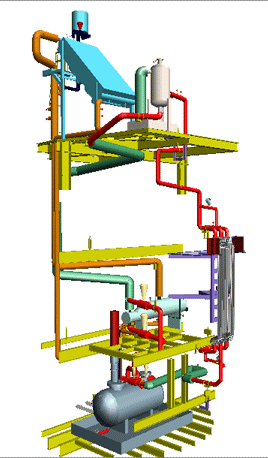

POINT-FOCUS CONCENTRATING SOLAR THERMAL TECHNOLOGIES
Development of amolten salt receiver for a solar thermal power plant
Participants: SENER Ingeniería y Sistemas, S.A. (ES), PSA-CIEMAT (ES); [2 CIEMAT Divisions participate in this project: a) PSA-CIEMAT, b) CIEMAT- Structural Materials Division].
Contacts: Juan Ignacio Burgaleta (ignacio.burgaleta@sener.es); Félix M. Téllez (felix.tellez@ciemat.es) (HSCG)
Funding: Budget 7 M€, of which SENER provides 4 M€, the CIEMAT provides 2 M€ and the CDTI-PIIC provides 1 M€.
Duration: November 17, 2005 to December 31, 2007 (Extended to December 2008)
Background: In 2004-2005, Boeing withdrew its offer to build the Solar Tres receiver, compromising continuation of the project in the absence of an alternative commercial offer. In view of this situation, SENER decided to undertake the engineering and development of the molten salt receiver for Solar Tres on its own. Nevertheless, in order to reduce the development risk, it requested CIEMAT assistance in sharing in the design and validation of a tube salt receiver, including design, building and testing a receiver panel prior to the fabrication of the Solar tres receiver, which will consist of 16 such panels. In the second half of 2005, SENER and CIEMAT signed a collaboration agreement for receiver technology validation (with SENER-CIEMAT technology) and definition of operating and control strategies to be applied in solar thermal power plants (starting with Solar Tres).
At the beginning of 2007, the CDTI approved inclusion of this Salt Receiver Development project for its support as a Subsidized Industrial Research Project to last until December 2008, which will increase the Solar Tres/Gemasolar plant receiver’s reliability and reduce its design risks.
Purpose:
- Reduce the risk associated with the first own development of a molten-salt central-receiver solar thermal power plant technology,
- Experimental validation of the Solar Tres receiver design, iii) Review of the selection of materials and geometries to extend the lifetime expectancy of the receiver. The equipment developed for the experiment is almost the complete system, lacking only the turbine and generator. It includes the 4‑MW thermal receiver subsystem, 18-ton molten salt storage tank, 1-MWh evaporator, air condenser, electrical tracing system, tubing, control and measurement system equipped with about 400 sensors.
Achievements in 2007: In February 2007, the molten salt solar receiver panel test plan began. By the end of July 2007, around 27 days of concentrated high-flux solar radiation testing had been completed, covering the most relevant part of the test plan, and reaching an incident flux of 1000 kW/m2 with a 20% salt flow.
SENER and CIEMAT then proceeded to evaluate the results, which led to final verification of the design expectations for reliability and efficiency, in September 2007. After a meeting where evaluation results were shared and SENER’s go ahead for promotion of the Gemasolar plant, the salt loop/receiver panel test plan continued in order to increase confidence in component operability and reliability. This campaign, thanks to CDTI_PIIC funding, was extended to the end of 2008, allowing the conditions the modules or receiver panels in the circular Gemasolar plant receiver will undergo to be simulated.
Testing has been continued to determine residual impurities in the salt mixtures from different suppliers to determine which ones produce the least corrosion in the receiver tubes and piping.
